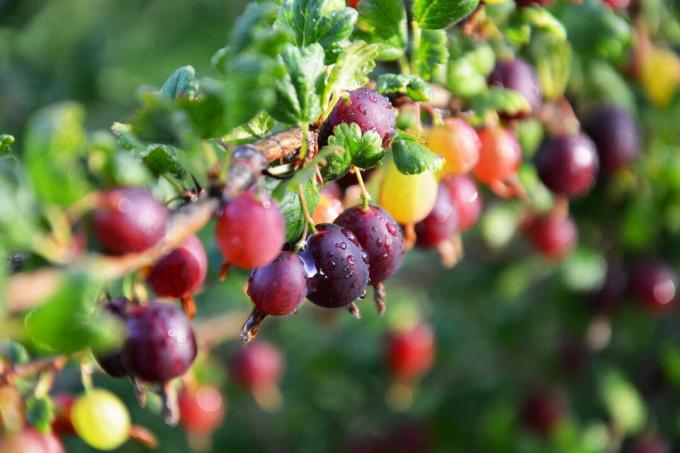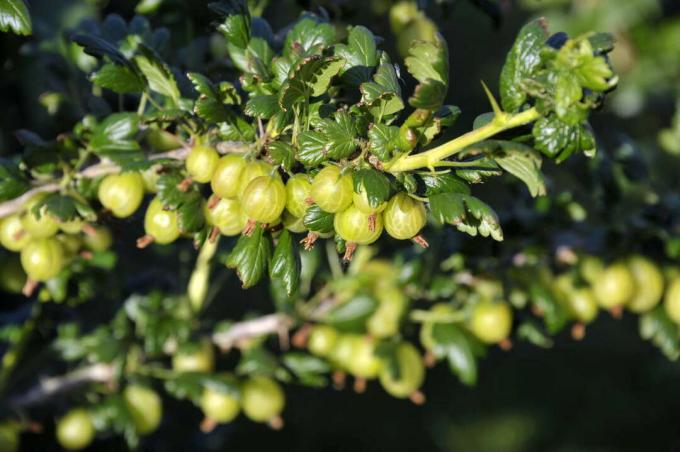We have compiled the best gooseberry varieties for you so that you can harvest the tastiest berries in your garden.

the Gooseberry (Ribes uva-crispa) originally comes from a wild form from Central and Eastern Europe and has been used since the 15th century. Cultivated for the fruit harvest in the 19th century. Almost all varieties are susceptible to American gooseberry powdery mildew, which was introduced to Europe around 1900. There are now resistant gooseberry varieties on the market, but these usually only produce very small fruits. The new varieties do not only differ in their fruit size. The color of the fruit, the hairiness, the (thorns) as well as the beginning of flowering and the ripening time can represent important criteria for the choice of the variety.
contents
- Green (white) gooseberry varieties
- Red gooseberry varieties
- Yellow gooseberry varieties
The trade primarily requires early-ripening shrubs with large berries that are as red as possible. That is why many old gooseberry varieties are only loved by fans today. A general distinction is made between varieties with green (white), red and yellow berries. Below we present a selection of the best gooseberry varieties for your home garden.
Green (white) gooseberry varieties
'Careless': British variety with early ripeness; poor growth, but high yields possible; very large, hairy fruits with a good taste.
'Invicta': An English cross of different varieties; with strong and upright growth, therefore well suited for hedge training; very early ripening (from mid-June); produces medium-sized, oval fruits with highly translucent veins; high and safe yields; short, soft thorns on the shoots; low susceptibility to mildew.

'Green Hansa' (also 'White Triumphal Berry'): An English cross from the 18th Century; mid-early harvest possible from the beginning of July; frost-resistant variety with regular and high yields; medium susceptibility to powdery mildew, otherwise very robust and vigorous; strong reinforcement; large, slightly hairy fruits with a fine aroma; however, the berries brown a lot during processing.
'Reflamba': A German variety with a late bloom; strong growth and high yields are possible; white-green, medium-sized fruits with little aroma; predominantly sour taste; low susceptibility to powdery mildew, but difficult harvest because of the large thorns.
'Green Ball': An old German variety from a seedling of 'Hönings Earliest'; high-yielding variety with medium ripening time; produces broad, oval, large fruits with a greenish-white color; sweet and sour aromatic taste; the fruits tend to burst, but hardly brown during processing; very susceptible to powdery mildew and cold damage.
Red gooseberry varieties
'Red Triumph' (also 'Winham’s Industry'): Old variety from Great Britain (originated around 1835); probably a chance seedling; medium early flowering and maturity; traditional main variety across Europe; regular and very high yields; several pickings necessary because ripening in a sequential manner; very strong reinforcement; large, oval fruits with a dark red color; densely downy hairy with thick skin and very good aroma; robust variety, but powdery mildew infestation possible.
'Pax': A British cross of different varieties; early variety with strong growth; good pickability due to the low spines on the shoots; large, medium-red fruits with little hair; prone to sunburn; resistant to powdery mildew and leaf fall.
'Rolonda': A late variety with dark red, medium-sized pods without hair; pleasant, sour taste; profitable; low reinforcement; burst-resistant fruits; resistant to powdery mildew.
'Xenia': A breed from Switzerland with a mid-late start of flowering; from mid-June can be harvested; weakly reinforced shoots; poor growth, but good yields; brown-red, large fruits with a good taste; not completely mildew proof; sensitive to sunburn.

,Achilles': Was bred in Great Britain as early as 1800; medium early variety (ripens in early July); strong upright growing with downwardly curved fruit shoots; suitable for hedge cultivation, but requires a strong pruning; very productive; large, smooth, purple-red fruits with a sweet aroma; solid shell; easy to pick; very susceptible to powdery mildew and leaf fall disease.
'Rokula' / 'Rocula': A cross with, among other things, a powdery mildew-resistant variety; medium-sized astringent habit, suitable for growing in hedges; pronounced thorns; early harvest possible; ripening sequentially; round, black-red, medium-sized fruits; very sensitive to bursting due to the delicate shell; very good aroma; resistant to powdery mildew.
'Remarka': A German variety; early harvest possible; purple, round, not hairy fruits with a sour taste; resistant to powdery mildew, but the fruits burst easily.
'May Duke': An old British variety; early variety with strong growth; low reinforcement; high yields possible; slightly hairy fruits with a sweet and sour taste; purple color; unfortunately a high sensitivity to sunburn, also very susceptible to powdery mildew.
Yellow gooseberry varieties
'Yellow Triumphal Berry' (also 'Triumphant'): A variety with medium-early ripeness; profitable; produces medium-sized, oval fruits; pale yellow color with translucent veins; sweet taste, but not very aromatic; strong clearing necessary, otherwise tendency to small fruitiness; well suited for processing.

'Höning's earliest': An old variety from Germany; ripens in early July; medium yield; strong growth; medium-sized, soft, golden yellow fruits with a very good taste; strong reinforcement available; is susceptible to leaf fall disease and requires strong thinning; sensitive to frost.
In case you choose the different Utilization methods of the gooseberry we have the right article ready for you with tips on freezing, boiling and co.
Tip: In addition to the variety, the nutrient supply of the gooseberries is also important. A primarily organic long-term fertilizer like our Plantura Organic universal fertilizer provides your gooseberry with all important nutrients for three months and promotes an active and healthy soil life.



